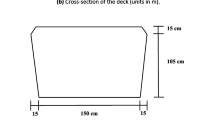Abstract
Elastomeric rubber bearings with side blocks have been extensively used as a seismic response-control device in steel girder bridges in Japan. In real scenarios, the behavior of the girder bridges with elastomeric bearings are usually complex because of the complex mechanism by which the seismically induced inertia forces at concrete deck transmits to the girder bearings. Therefore, it is important to carry out seismic response analysis of a whole bridge system considering the interaction between different structural components in order to check the performance of the side blocks during an event of severe earthquakes. The objectives of the present study are to develop a detailed three-dimensional finite element (FE) model of an elevated girder bridge system and to propose a design rupture strength for the side blocks. The FE-model is constructed based on an existing plate girder bridge considering the effect of concrete slab, girders, stiffeners, rubber bearing, pier and the damage control by the side blocks. A sequence of seismic response analysis is then performed using four different rupture forces of the side blocks by considering the Level-2 design earthquake, the 1995 Kobe earthquake and the 2016 Kumamoto earthquake. The analytical investigation reveals that the side blocks should be designed to withstand a horizontal force of at least 1200 kN in order to prevent the rupture of the side blocks and to mitigate damage of bridge piers. Moreover, the damage to the critical parts of bridge superstructure can be mitigated by strengthening the side blocks. Based on the analysis results, a retrofit plan to strengthen the side blocks of existing girder bridges is proposed.


















Similar content being viewed by others
References
Abe, M., & Fujino, Y. (2017). Monitoring of long-span bridges in Japan. Proceedings of the Institution of Civil Engineers - Civil Engineering,170(3), 135–144.
Carden, L. P., Itani, A. M., & Buckle, I. G. (2006). Seismic performance of Steel Girder Bridges with ductile cross frames using buckling restrained braces. Journal of Structural Engineering,132(3), 338–345.
Cho, S., Yun, C. B., Lynch, J. P., et al. (2008). Smart wireless sensor technology for structural health monitoring of civil structures. Steel Structures,8, 267–275.
Dassault Systemes Simulia Corp. (2018). ABAQUS 6.14 Documentation. Providence, RI: Dassault Systemes Simulia Corp.
Filipov, E. T., Revell, J. R., Fahnestock, L. A., LaFave, J. M., et al. (2013). Seismic performance of highway bridges with fusing bearing components for quasi-isolation. Earthquake Engineering and Structural Dynamics,42(9), 1375–1394.
Ishihara, K., Matsumura, M., Yoshida, M., & Sakaida, M. (2011). Knock-off effect of steel side block as displacement restrainers on dynamic response of isolated bridge structure. Procedia Engineering,14, 2341–2349.
Itani, A. M., Bruneau, M., Carden, L., & Buckle, I. G. (2004). Seismic behavior of steel girder bridge superstructures. Journal of Bridge Engineering,9, 243–249. https://doi.org/10.1061/(ASCE)1084-0702(2004)9:3(243).
Japan Bridge Association. (2018). Bridges yearbook database. Retrieved from December 3, 2018 http://www.jasbc.or.jp/kyoryodb/index.cgi (in Japanese).
Japan Road Association. (2002). Part V: Seismic design, design specifications of highway bridges. Tokyo: Maruzen.
Japan Road Association. (2004). Handbook of road bridge bearing. Tokyo: Japan Road Association. (in Japanese).
Kawashima, K. (2012). Damage to bridges due to the 2011 great east Japan earthquake. Journal of Japan Association for Earthquake Engineering,12(4), 319–338.
Kawashima, K., & Unjoh, S. (1997). The damage of highway bridges in the 1995 Hyogo-ken Nanbu earthquake and its impact on Japanese seismic design. Journal of Earthquake Engineering,1(3), 505–541.
Kawashima, K., & Unjoh, S. (2004). Seismic design of highway bridges. Journal of Japan Association for Earthquake Engineering,4(3), 174–183.
Koto, Y., Konishi, T., Sekiya, H., & Miki, C. (2019). Monitoring local damage due to fatigue in plate girder bridge. Journal of Sound and Vibration,438, 238–250.
Maleki, S. (2005). Seismic modeling of skewed bridges with elastomeric bearings and side retainers. Journal of Bridge Engineering,10(4), 442–449.
Matsumoto, T., Kawashima, K., & Watanabe, G. (2007). Seismic response of 3-span bridge considering the effect of failure of bearings. Journal of Structural Engineering (JSCE),53A, 503–512.
Monzon, E. V., Buckle, I. G., & Itani, A. M. (2016). Seismic performance and response of seismically isolated curved steel I-girder bridge. Journal of Structural Engineering,142(12), 04016121.
Mustafa, S., Sekiya, H., & Miki, C. (2020). Determining the location of sensors for seismic damage detection in steel girder bridges with elastomeric bearings. Journal of Vibration and Control,0(0), 1–12. https://doi.org/10.1177/1077546320905176.
Nazmy, A. S. (2003). Seismic analysis and design evaluation of continuous plate-girder bridges: a case study. International Journal of Structural Stability and Dynamics,3(1), 91–106.
Takahashi, Y., & Hoshikuma, J. (2013). Damage to road bridges induced by ground motion in the 2011 great east Japan earthquake. Journal of JSCE,1, 398–410.
Usami, T., Lu, Z., Ge, H., & Kono, T. (2004). Seismic performance evaluation of steel arch bridges against major earthquakes. Part 1: Dynamic analysis approach. Earthquake Engineering and Structural Dynamics,33(14), 1337–1354.
Yokota, A., & Akiyama, H. (2013). Tokyo Gate Bridge: Its monitoring system and preventive maintenance. JSCE Civil Engineers,98(11), 30–31. (in Japanese).
Acknowledgements
This study was carried out as part of the research branding project by Tokyo City University. The drawings of the target bridge were provided by the Metropolitan Expressway Co., Ltd. We express our gratitude to Mr. Hirano of the Metropolitan Expressway Co., Ltd. and everyone else involved.
Author information
Authors and Affiliations
Corresponding author
Additional information
Publisher's Note
Springer Nature remains neutral with regard to jurisdictional claims in published maps and institutional affiliations.
Rights and permissions
About this article
Cite this article
Mustafa, S., Miki, C. Design of Rupture Strength of Side Blocks in Elevated Steel Girder Bridges with Elastomeric Bearings. Int J Steel Struct 20, 885–896 (2020). https://doi.org/10.1007/s13296-020-00329-1
Received:
Accepted:
Published:
Issue Date:
DOI: https://doi.org/10.1007/s13296-020-00329-1




